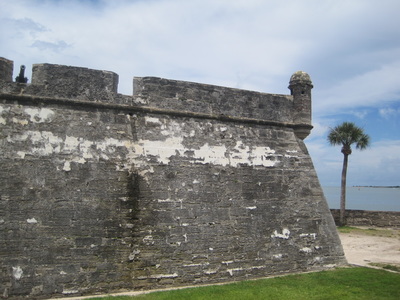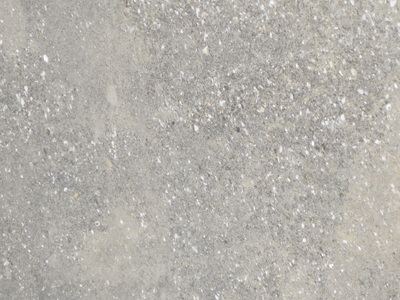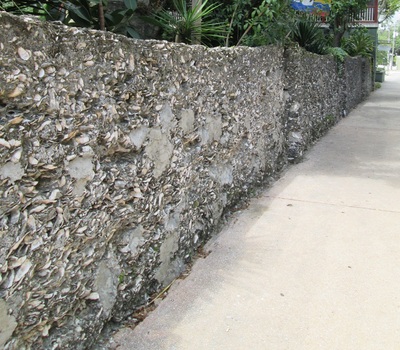St. Augustine is the original home of tabby in America. The Spanish arrived in St. Augustine in 1565, and the first documented reference to tabby occurred in 1580. In fact, the word “tabby” may derive from the Spanish word tapia, meaning “mud wall.” Also in 1580, the Spanish discovered coquina, a natural shellstone that could be quarried, so the oldest surviving buildings of Spanish rule are a combination of coquina and tabby. The British takeover of the city in 1764 ushered in the destruction of most tabby buildings, so there are few remnants today. (For more information on the history of St. Augustine tabby, see Janet H. Gritzner’s article, “Distributions of Tabby in the Southern United States,” in The Conservation and Preservation of Tabby.)
The sites listed below illustrate the history of tabby and the Spanish colony in St. Augustine:
Mission de Nombre de Dios
It is here on Mission Grounds in 1565 that Pedro Menéndez de Avilés landed and began the Spanish colony in Florida. A marker in the historic park indicates the location of the oldest known tabby and coquina—the foundations of a church and friary dating from 1677. Unfortunately, archaeologists have covered the ruins, so only the marker is visible.
The sites listed below illustrate the history of tabby and the Spanish colony in St. Augustine:
Mission de Nombre de Dios
It is here on Mission Grounds in 1565 that Pedro Menéndez de Avilés landed and began the Spanish colony in Florida. A marker in the historic park indicates the location of the oldest known tabby and coquina—the foundations of a church and friary dating from 1677. Unfortunately, archaeologists have covered the ruins, so only the marker is visible.
GPS: N 29°54.302 and W 81°19.007 (parking lot)
Address: 27 Ocean Avenue, St. Augustine, FL 32084
Accessibility: The mission is open to the public and consists of a museum, church, chapel, and historic park (although the archaeological excavation is covered and unavailable for public viewing). For more information, visit the website of the Mission de Nombre de Dios.
Castillo de San Marcos
Constructed 1672-1695, the massive Castillo de San Marcos is the oldest standing fort in the United States. It was built primarily with coquina, but some tabby was used. (However, it seems to me that in St. Augustine the floors identified as tabby have much smaller and fewer shells than tabby elsewhere.)
Address: 27 Ocean Avenue, St. Augustine, FL 32084
Accessibility: The mission is open to the public and consists of a museum, church, chapel, and historic park (although the archaeological excavation is covered and unavailable for public viewing). For more information, visit the website of the Mission de Nombre de Dios.
Castillo de San Marcos
Constructed 1672-1695, the massive Castillo de San Marcos is the oldest standing fort in the United States. It was built primarily with coquina, but some tabby was used. (However, it seems to me that in St. Augustine the floors identified as tabby have much smaller and fewer shells than tabby elsewhere.)
Location
GPS: N 29°53.798 and W 81°18.676
Address: 1 S. Castillo Drive, St. Augustine, FL 32084
Accessibility: There is a parking lot in front of the fort and at the nearby Visitor Center. Open every day, except Christmas, from 8:45am-4:45pm. Admission is $7 for those over the age of 15. For more information see the website for the Castillo de San Marcos National Monument.
St. George Street Tabby Walls
St. George Street is a popular pedestrian walkway with stores and restaurants in the heart of the historic district. Most of the tabby walls along historic St. George Street are stuccoed, but exposed tabby can be seen in a couple of spots.
GPS: N 29°53.798 and W 81°18.676
Address: 1 S. Castillo Drive, St. Augustine, FL 32084
Accessibility: There is a parking lot in front of the fort and at the nearby Visitor Center. Open every day, except Christmas, from 8:45am-4:45pm. Admission is $7 for those over the age of 15. For more information see the website for the Castillo de San Marcos National Monument.
St. George Street Tabby Walls
St. George Street is a popular pedestrian walkway with stores and restaurants in the heart of the historic district. Most of the tabby walls along historic St. George Street are stuccoed, but exposed tabby can be seen in a couple of spots.
Location
One wall is by the Oldest Wooden Schoolhouse in the U.S. at 14 St. George Street and Tolomato Lane
(GPS Coordinates N 29°53.847 and W 81°18.818).
Another is by Mill Top Tavern at 19 St. George Street
(GPS Coordinates N29°52.824, W81°18.809).
Accessibility
Park at the nearby Visitor Center, which is also close to the Castillo San Marcos. The Visitor Center is located off I-95 at 10 W. Castillo Dr, St Augustine, FL 32084. For more information, see http://www.staugustinegovernment.com/sites/vicparking/index.cfm.
One wall is by the Oldest Wooden Schoolhouse in the U.S. at 14 St. George Street and Tolomato Lane
(GPS Coordinates N 29°53.847 and W 81°18.818).
Another is by Mill Top Tavern at 19 St. George Street
(GPS Coordinates N29°52.824, W81°18.809).
Accessibility
Park at the nearby Visitor Center, which is also close to the Castillo San Marcos. The Visitor Center is located off I-95 at 10 W. Castillo Dr, St Augustine, FL 32084. For more information, see http://www.staugustinegovernment.com/sites/vicparking/index.cfm.







 RSS Feed
RSS Feed
